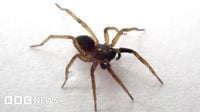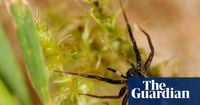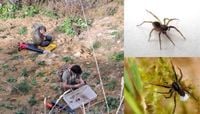On a windswept autumn day just before Halloween, an extraordinary discovery unfolded on the Isle of Wight—one that has sent ripples of excitement through Britain’s conservation and arachnology communities. After vanishing from sight for four decades, the critically endangered white-knuckled wolf spider (Aulonia albimana) was rediscovered at the National Trust’s Newtown National Nature Reserve on October 30, 2025. The tiny, orange-legged arachnid, last recorded in the UK in 1985, was feared extinct. Its dramatic return is now being hailed as one of Britain’s most significant wildlife comebacks of the century.
The rediscovery was nothing short of a race against time. Entomologists Mark Telfer and Graeme Lyons embarked on a four-hour search in a remote, overgrown area of the reserve—an area accessible only by boat and located about 2 kilometers from the spider’s former colony. As the clock ticked down, Lyons made the first sighting with just nine minutes to spare, and the second in the final minute before their boat was due to depart. “I’ve seen 559 species of spider in the British Isles and this one was by far the most exciting find!” Lyons exclaimed, according to Metro. Telfer echoed the sentiment, describing the discovery as “unforgettable.”
The white-knuckled wolf spider, as the team informally named it, is a dapper little creature with distinctive pale patches—like tiny knuckles—on the palps beside its mouth. This unique feature, along with its diminutive size and orange legs, helped the team confirm its identity. “The name was inspired by the pale ‘knuckles’ and the drama of finding it just in time,” Telfer noted, as reported by BBC News.
But what makes this rediscovery so remarkable isn’t just the spider’s rarity or the suspenseful search. It’s also a testament to the power of targeted conservation. The National Trust, supported by Natural England’s Species Recovery Programme, has spent years restoring the reserve’s habitat. Once overgrown, the area has been transformed with the help of a flock of Hebridean sheep. Their grazing keeps the limestone grassland short and sunlit—creating the patchy, open turf that Aulonia albimana prefers for hunting and breeding. “We’ve been managing this rare limestone grassland for years to encourage wildlife diversity. Seeing that work pay off with the return of such a rare species is incredibly rewarding,” said Paul Davies, Countryside Manager for the National Trust on the Isle of Wight, as quoted by Island Echo.
Dr Helen Smith, conservation officer for the British Arachnological Society, was effusive in her praise for all involved. “The remarkable discovery of this dapper little spider on the Isle of Wight is one of Britain’s epic ‘lost species’ rediscoveries of the century,” she said. Smith highlighted the years of failed searches and the sense of loss that had settled over the community. “With repeated failure to find it at its former sites, where its open habitat has been lost, it seemed increasingly likely that it had joined the country’s sad list of extinct species.” The rediscovery, she added, shows that with the right habitat restoration, even species teetering on the brink can be given a second chance. “The white-knuckled wolf spider not only had a place to hang on, but hopefully one in which it can now thrive.”
The find is also a first in another way: this is the first time Aulonia albimana has been digitally photographed in the UK, providing crucial documentation for future research and conservation efforts.
Wolf spiders, of which there are about 38 species living in the UK, are famed for their agile hunting skills. They chase their prey along the ground and pounce with the precision of their namesake. Yet, the white-knuckled wolf spider adds a twist to the tale: it is also known to spin a flimsy web, a behavior that sets it apart from its relatives and adds a touch of mystery to its already elusive nature. As BBC News reported, the National Trust described its hunting techniques as “something of a mystery.”
The rediscovery has not only brought joy to scientists and conservationists but has also inspired a wider public campaign. The National Trust has launched a new “Wild Senses” initiative, fronted by wildlife presenter Hamza Yassin, encouraging people to get outdoors and connect with nature this autumn. “Not everyone will spot something this rare, but autumn is a wonderful time for wildlife watching,” said Rosie Hails, the Trust’s Director of Nature and Science. “There’s always drama in the natural world—you’ve just got to pause and notice it.”
The story of the white-knuckled wolf spider’s return is a vivid reminder of what’s at stake in the battle to save Britain’s endangered species. The spider’s disappearance was closely linked to habitat loss, as open grasslands became overgrown and unsuitable for its survival. The success at Newtown National Nature Reserve demonstrates the importance of active habitat management and the sometimes surprising allies—like Hebridean sheep—that can help restore balance to fragile ecosystems.
Looking ahead, the British Arachnological Society and the National Trust are eager to build on this success. Dr Smith expressed hope for the future: “We look forward to working with the National Trust to establish the full extent of the population and determine the conditions it needs to expand its range and secure its future.” The rediscovery has energized efforts to monitor the population and ensure that the white-knuckled wolf spider remains a living part of Britain’s natural heritage, rather than a footnote in its history.
For the entomologists who made the find, the experience was a career-defining moment. “To find a species thought lost for 40 years is thrilling—and testament to how the right habitat management, combined with curiosity and collaboration, can deliver remarkable results,” Telfer told BBC News. Lyons, reflecting on the odds and the excitement, added, “This was probably the longest long shot I’ve ever taken part in.”
As the autumn sun sets over the Isle of Wight, the tale of the white-knuckled wolf spider serves as both a celebration and a call to action. It’s a reminder that with determination, partnership, and sometimes a bit of luck, even the most elusive creatures can be brought back from the edge. For now, at least, the Isle of Wight is home once again to a tiny, orange-legged survivor whose story has captured the imagination of a nation.






